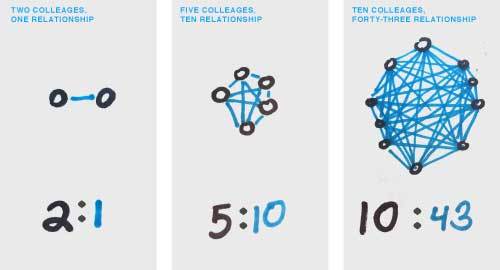Sex in stairwells, absentee management, and outright racism. There's been a spate of news recently about cultures going awry in Silicon Valley. While it's the extreme cases here on the left coast that are making the headlines, errant cultures effect companies of all kind and size. It seems keeping culture from unraveling is a significant challenge every growth organization must learn to manage if its leaders intend to succeed in the long run.
In modestly sized organization, a limited set of individuals rely on one another to get work done, usually becoming a tight bunch in the process. Let's call this an intimate community: a group of people where "most of the members recognize and are recognized by many of the others". By nature and necessity when put together individuals develop relationships, and when intimate communities form they enable the knowing of the "who's and what's" of the organization. (Everyone knows Shelby is the code base wizard; Sanjay broke the sales records last quarter.)
The connections we have with one another enable this pervasive knowing--where one person can have a sense of what's happening throughout the company. In turn this kind of knowing strengthens our connections. It's a self-reinforcing loop, where relationships serve as the synapses of business.
But what happens when hiring kicks into overdrive and more people show up for work? The number of relationships we need to manage explodes, and at some point it's too much for our brains, even with the help of new hire emails and org charts.
As a result of constant growth, whether by acquisition or placement, the percentage of who's and what's each individual knows diminishes, eventually weakening the relationship of any one individual to the company as a whole. We tend to trust those with whom we have history. We understand their motivations, and can predict how they'll react. What do we do when we are seemingly surrounded by people we don't quite recognize?
Culture is fostered by relationships, but when those relationships become unmanageable humans look to the safety of those they know and trust. Whether they realize it or not every leader of every growth organization will face the phenomena of staff subdividing into intimate communities.
The question for leaders who want to design their culture, not just let it happen to them, becomes when does this subdivision begin? Is there a magic number of employees when culture changes? And what can be done about it?
This article is first in a series exploring the why, when, and how of managing company culture in growth organizations by Josh Levine.
Josh Levine is a speaker, consultant, and educator of all things culture. His writing has been featured in publications including Fast Company, The Design Management Journal, and 99u Magazine. You can follow him around the web @akajoshlevine.

